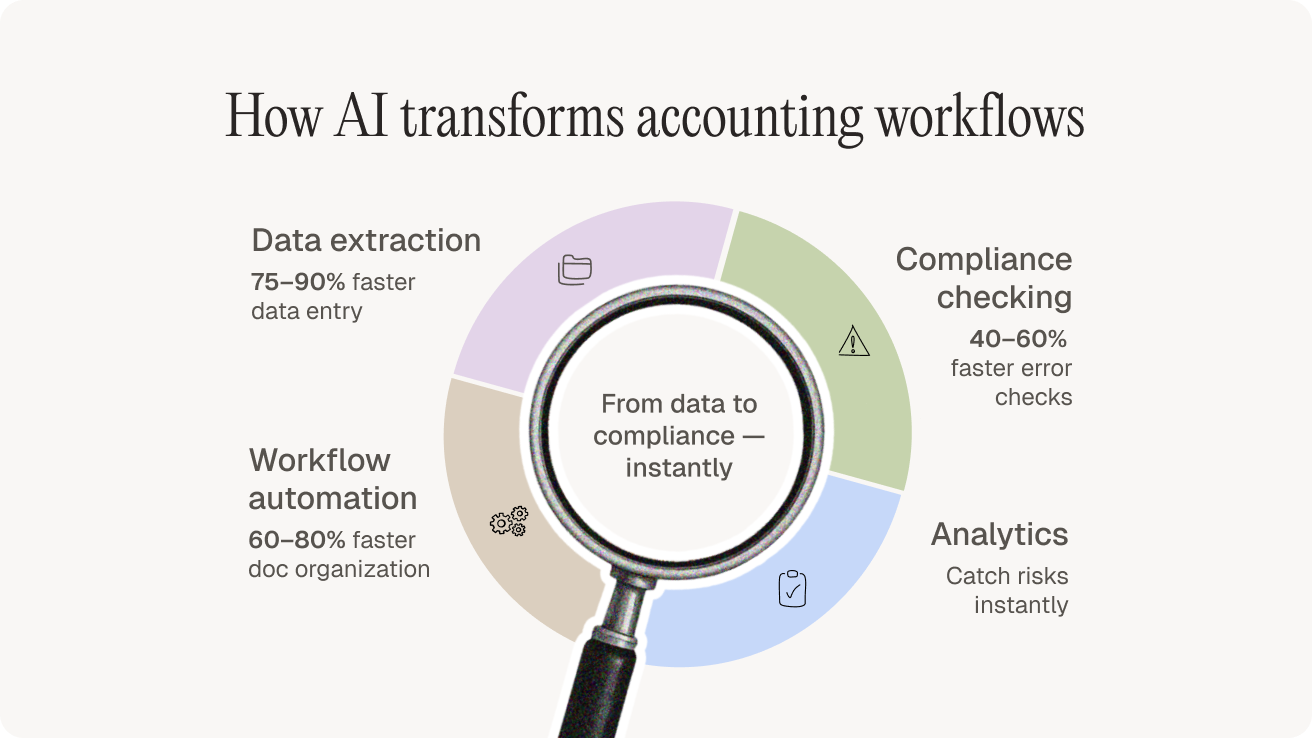Accounting is changing — fast. The profession has been bogged down for decades by paperwork, endless reviews, and staffing shortages that never go away. AI is cutting through all of it.
AI isn’t one piece of software. It’s a set of tools that read data, recognize patterns, and improve over time. In other words: it handles the grunt work that eats up your team’s time, while you stay focused on judgment, strategy, and client relationships.
This guide breaks down how AI fits into modern accounting, from data extraction to compliance.
What AI means for modern accounting workflows
Traditional workflows still run on manual input. Think endless typing, sorting, double-checking, and chasing clients for missing docs. That’s why firms outsource overseas or risk burning out staff during the busy season.
AI flips the model like this:
- Data extraction: Pulls numbers straight from W-2s, 1099s, K-1s, bank statements.
- Workflow automation: Routes documents and tasks automatically.
- Compliance checking: Applies current tax rules in real time.
- Analytics: Finds patterns and risks across returns.
The result? Faster returns, fewer errors, and staff who aren’t stuck in data-entry purgatory.
Why data extraction is the cornerstone of automated tax work
Manual data entry is the single biggest time sink in tax prep. AI replaces it with OCR and machine learning that reads forms, pulls the numbers, and maps them instantly. Accuracy rates typically top 95% — better than a tired staffer in March.
Modern AI systems can extract data from:
- W-2 forms
- 1099 forms
- K-1 statements
- Bank statements
- Receipts and invoices
- Prior year tax returns
This isn’t just “faster typing.” It’s no typing.
Bank statement parsing
AI tools can now read bank statements from different financial institutions, regardless of format. The system identifies transaction dates, amounts, payees, and descriptions, then organizes this information into categories that match tax form requirements.
For example, AI can:
- Identify a recurring payment
- Categorize it as a business expense
- Match it with a receipt in the system
- Place the data in the correct field on Schedule C
And it all happens in seconds.
K-1 data extraction
K-1 forms are particularly challenging. Manual processing can take over an hour per document. AI systems trained on thousands of K-1 forms can quickly locate important information like:
- Partner share percentages
- Capital account changes
- Income allocations by category
- Tax credits
Data flows directly into the tax return. Processing now takes minutes, not hours.
Workflow automation tactics that reduce manual effort
Once data is extracted, AI doesn’t stop. It moves returns through the workflow automatically:
- Assigns returns based on complexity.
- Tracks documents and reminders.
- Pushes completed prep into review queues.
- Notifies clients of status updates.
These automated processes save 75-90% of the time spent on routine tasks compared to manual methods.
Intelligent transaction matching
One of the biggest time drains in tax prep is transaction matching — lining up bank statements, credit card charges, and receipts by hand. AI kills that bottleneck.
The system runs comparisons automatically, using a confidence score to decide if two entries match. High-confidence matches? Processed instantly. Lower-confidence ones? Flagged for a quick human check.
Example: a $1,500 bank payment to Dell on March 15 gets auto-matched to the Dell equipment receipt from the same date. No data hunting, no second-guessing, no wasted hours.
Real-time error checks
AI systems continuously check for inconsistencies as data is processed, including:
- Missing information
- Mathematical errors
- Duplicate entries
- Mismatches between documents
By flagging issues in real time, AI cuts down review hours and fixes problems before they snowball. The result: faster prep and fewer mistakes than manual review ever catches.
How AI powers compliance and fraud detection
Compliance doesn’t wait for your staff to memorize the latest rule change. AI systems like Filed update automatically and apply those rules to every return. These systems can:
- Apply the latest tax rules automatically
- Flag potential compliance issues
- Identify unusual patterns that might indicate errors or fraud
- Support documentation for audit defense
This reduces the burden on accountants to track every regulatory change while improving compliance accuracy.

Automated regulatory updates
When tax laws change, AI updates automatically. No scrambling through checklists, no missed updates. Example: when the standard deduction jumped under the Tax Cuts and Jobs Act, AI applied the new amounts across every eligible return instantly.
It happens without manual intervention, keeping every return current and slashing the risk of human error.
Real-time anomaly alerts
AI doesn’t just crunch numbers — it spots what doesn’t add up. The system scans financial data for anything outside the norm and throws an alert when something looks off.
What gets flagged?
- Income with no matching deposits
- Expenses way above prior years
- Deductions outside normal ranges for similar clients
- Missing docs tied to big transactions
These alerts surface problems early, cutting audit risk and stopping penalties before they hit.
Steps to implement AI in your accounting practice
AI like Filed doesn’t require blowing up your workflow. You can start small and expand fast. Here’s how:
Define clear goals
Identify your worst time sinks – usually data entry, document handling, form prep, or reconciliation.
Set measurable goals, like "reduce data entry time by 30%" or "increase returns processed per preparer by 25%."
Choose the right AI platform
Look for systems designed specifically for accounting tasks rather than general-purpose AI. Key features to consider include:
- High accuracy rates on tax docs
- Seamless integration with your tax software
- SOC 2 compliance
- Training and support options
Filed is built specifically for tax preparation workflows with pre-trained models for common tax documents.
Start small and expand
Begin with a limited implementation focused on a specific task or document type. Learn the system and measure results before expanding:
- Start with W-2 and 1099 extraction
- Add bank statement processing
- Implement workflow automation
- Add compliance checking
This gradual approach reduces disruption while allowing you to measure the impact at each stage.
Train your team: Admins handle uploads, preparers handle reviews, and managers track results. Most teams adapt in under a week.
Typical rollout:
- Month 1: Train and test.
- Month 2: Run a pilot batch.
- Next season: Scale across return types.
Real cost savings with AI tools
The ROI is immediate:
- $100 saved per return on average.
- 30–40% more returns processed with the same staff.
- 40–60% fewer errors, lowering audit risk.
- Faster turnaround → happier clients.
For a firm handling 500 returns, that’s $50K in savings or new capacity every season.

Your next steps with AI for accountants
AI is already an essential part of modern accounting. It eliminates the manual grind, reduces risk, and frees your team to focus on advisory and client service.
Filed makes it simple. Our AI-powered platform automates tax prep from document intake to review-ready returns, integrates with your current software, and adapts to your firm’s workflow.
Apply for early access at filed.com/early-access
FAQs about AI for accountants
What tax documents can AI process?
Filed can process standard forms, including W-2s, 1099s, K-1s, bank statements, receipts, with 95%+ accuracy.
How does AI protect client data?
Filed is SOC 2 compliant and features end-to-end encryption, role-based access, and full audit trails.
How long does implementation take?
Usually days to weeks. Many firms start with a single workflow, then expand.
Can AI integrate with my tax software?
Yes. Filed connects with major platforms like Drake, ProSeries, Lacerte, and Ultra Tax, via secure APIs.
Will AI replace accountants?
No. AI automates tasks. Humans handle strategy, relationships, and judgment.




.png)

